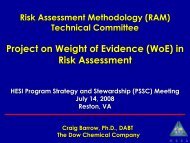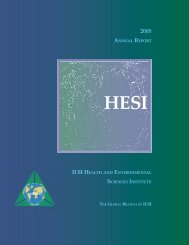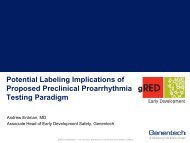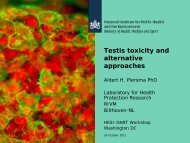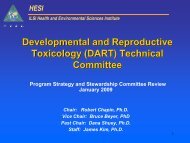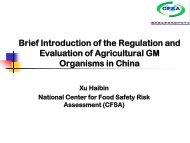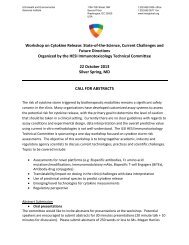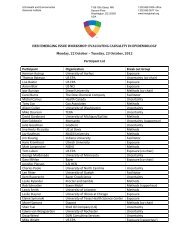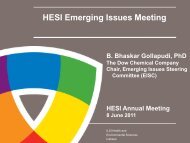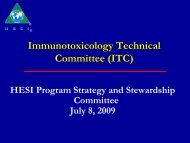View Presentation - ILSI Health and Environmental Sciences Institute
View Presentation - ILSI Health and Environmental Sciences Institute
View Presentation - ILSI Health and Environmental Sciences Institute
Create successful ePaper yourself
Turn your PDF publications into a flip-book with our unique Google optimized e-Paper software.
HESI PROTEIN ALLERGENICITY<br />
TECHNICAL COMMITTEE (PATC)<br />
PATC Stewardship<br />
Review by the<br />
HESI Board PSSC<br />
29 April 2013<br />
<strong>ILSI</strong> <strong>Health</strong> <strong>and</strong><br />
<strong>Environmental</strong> <strong>Sciences</strong><br />
<strong>Institute</strong>
Leadership <strong>and</strong> Staffing<br />
Co-Chairs:<br />
Dr. Gregory Ladics (DuPont Pioneer)<br />
Dr. Scott McClain (Syngenta USA)<br />
Prof. Ronald van Ree (Academic<br />
Medical Center, University of<br />
Amsterdam)<br />
Staff: Nancy G. Doerrer, MS (HESI)<br />
<strong>ILSI</strong> <strong>Health</strong> <strong>and</strong><br />
<strong>Environmental</strong> <strong>Sciences</strong><br />
<strong>Institute</strong><br />
2
Public <strong>and</strong> Private Sector<br />
Participation<br />
Public Participants:<br />
Academic Medical Center,<br />
University of Amsterdam,<br />
Netherl<strong>and</strong>s<br />
Copenhagen University<br />
Hospital at Gentofte, Denmark<br />
Guangzhou Medical University<br />
(China) – new<br />
US <strong>Environmental</strong> Protection<br />
Agency<br />
US Food <strong>and</strong> Drug<br />
Administration<br />
<strong>ILSI</strong> <strong>Health</strong> <strong>and</strong><br />
<strong>Environmental</strong> <strong>Sciences</strong><br />
<strong>Institute</strong><br />
Sponsors:<br />
BASF Plant Science<br />
Bayer SAS<br />
DuPont Pioneer<br />
Monsanto Company<br />
Dow Agro<strong>Sciences</strong><br />
Syngenta USA<br />
3
2010-2020 HESI COMBINED CHALLENGES MAP<br />
The PATC addresses several issues on the HESI Combined Challenges Map.<br />
Relative<br />
impact<br />
Animal use <strong>and</strong><br />
welfare<br />
Vaccine<br />
development, use,<br />
<strong>and</strong> safety<br />
Genomics<br />
Human health:<br />
scientific evaluation<br />
of sensitive<br />
populations<br />
Sustainability<br />
Stem cell technology<br />
Food safety<br />
Communication <strong>and</strong><br />
perception of risk<br />
versus benefit<br />
Improved risk<br />
assessment through<br />
biomonitoring <strong>and</strong><br />
epidemiology<br />
Risk / benefit:<br />
regulation of<br />
chemicals in<br />
commerce<br />
Translational<br />
biomarkers<br />
Risk assessment of<br />
sensitive / vulnerable<br />
populations<br />
<strong>Environmental</strong> quality<br />
Emerging<br />
contaminants<br />
Safety of genetically<br />
modified organisms<br />
<strong>and</strong> foods<br />
Regulatory<br />
framework for new<br />
methods<br />
Computational tools /<br />
toxicology<br />
Use of science in<br />
setting public policy<br />
“Omics” in risk<br />
assessment<br />
Risk assessment of<br />
co-exposures<br />
Nanomaterials /<br />
nanotechnology<br />
Paradigm shifts in<br />
risk assessment / life<br />
cycle assessment<br />
Stem cell therapy<br />
Individual<br />
susceptibility<br />
Improved testing <strong>and</strong><br />
assessment<br />
strategies<br />
Regulatory framework<br />
for carcinogenicity<br />
testing<br />
Alternatives to animal<br />
models<br />
Epigenetics in risk<br />
assessment<br />
Exposure-based risk<br />
assessment<br />
Improved<br />
biomonitoring<br />
through biomarkers<br />
Time: immediate (2010) to long-term (2020)<br />
Each axis appearing on the 2010-2020 HESI Combined Challenges Map is a continuum. All issues on the map are of high importance/impact based on prioritization by<br />
the participants in the 2009 HESI mapping exercise. “Relative impact” is a qualitative measure of importance among high priority topics. The location of issues along the<br />
“time” continuum is an approximation of when the topic is likely to become a major issue in the timeframe from 2010 to 2020.
PATC Mission<br />
To advance the scientific underst<strong>and</strong>ing of<br />
the relevant parameters defining allergenic<br />
proteins, as well as to encourage the<br />
development of reliable <strong>and</strong> accurate<br />
methodologies for characterizing the<br />
allergenic potential of novel proteins.<br />
<strong>ILSI</strong> <strong>Health</strong> <strong>and</strong><br />
<strong>Environmental</strong> <strong>Sciences</strong><br />
<strong>Institute</strong><br />
5
HESI PATC is Qualified to Address<br />
Allergy Safety Issues<br />
<br />
<br />
<br />
<br />
The PATC’s reputation for unbiased, scientific consensus-building<br />
provides an excellent forum for government, academic, <strong>and</strong> industry<br />
scientists to work collaboratively to move the science in this area forward.<br />
This is the only HESI committee devoted exclusively to science issues<br />
associated with agricultural biotechnology – a technology that impacts 14<br />
million farmers in 25 countries <strong>and</strong> millions of consumers (Crop Life,<br />
2010).<br />
PATC members are experts in the fields of biochemistry, allergy, <strong>and</strong><br />
toxicology, <strong>and</strong> have an extensive professional network that helps support<br />
the various workshops, basic research, <strong>and</strong> outreach on a global scale.<br />
For the last ~2 years, we have had consistent participation by two primary<br />
academic advisors (1 is a co-chair) <strong>and</strong> 2-3 government representatives<br />
(US EPA <strong>and</strong> US FDA). The PATC has also built an extensive network of<br />
academic experts in various fields that provides a basis for ongoing<br />
symposia concepts.<br />
<strong>ILSI</strong> <strong>Health</strong> <strong>and</strong><br />
<strong>Environmental</strong> <strong>Sciences</strong><br />
<strong>Institute</strong><br />
6
Objectives<br />
Promote underst<strong>and</strong>ing of what makes a protein<br />
allergenic;<br />
Establish processes useful in a weight-ofevidence<br />
approach to the evaluation of novel<br />
proteins expressed in biotechnology products;<br />
Develop scientific uniformity for these<br />
evaluations; <strong>and</strong><br />
Communicate scientific findings to the<br />
academic, industry, <strong>and</strong> regulatory<br />
communities.<br />
<strong>ILSI</strong> <strong>Health</strong> <strong>and</strong><br />
<strong>Environmental</strong> <strong>Sciences</strong><br />
<strong>Institute</strong><br />
7
Strategy to Fulfill Mission<br />
Focused workshops/symposia with experts<br />
from government, academia, <strong>and</strong> industry<br />
Support <strong>and</strong> direct basic research to evaluate<br />
utility of in vivo methods<br />
Harmonize the development of common<br />
approaches for in vitro assessments<br />
Peer-reviewed publications<br />
Outreach activities to update the state-of-the-art<br />
in allergy science <strong>and</strong> the role played by new<br />
information in regulatory safety assessment of<br />
food <strong>and</strong> feeds<br />
<strong>ILSI</strong> <strong>Health</strong> <strong>and</strong><br />
<strong>Environmental</strong> <strong>Sciences</strong><br />
<strong>Institute</strong><br />
8
PATC Areas of Interest<br />
Biochemical<br />
Parameters<br />
associated with<br />
allergenic proteins<br />
Sequence<br />
Homology /<br />
Bioinformatics<br />
evaluations<br />
Animal Models for<br />
predicting human<br />
food allergy<br />
Sera Bank<br />
development<br />
Detection Methods<br />
to support<br />
endogenous allergen<br />
assessments<br />
<strong>ILSI</strong> <strong>Health</strong> <strong>and</strong><br />
<strong>Environmental</strong> <strong>Sciences</strong><br />
<strong>Institute</strong><br />
9
Global PATC Impact<br />
2009<br />
2004<br />
2002<br />
2003<br />
2007<br />
2008<br />
2013<br />
2012<br />
2001<br />
2006<br />
2007<br />
2009<br />
2011<br />
2013<br />
2005<br />
2005<br />
2006<br />
2012<br />
2006<br />
2007<br />
2009<br />
2006<br />
2012
Collaboration with International<br />
Agencies <strong>and</strong> <strong>ILSI</strong> Branches: Examples<br />
Joint Workshop, Beijing, China, April 2013<br />
At the request of Chinese regulators, the PATC supported <strong>and</strong><br />
coordinated a broadly-scoped meeting on food allergy <strong>and</strong> food <strong>and</strong><br />
feed safety assessment of biotech (GM) crops. (Follow-up to a<br />
November 2011 allergy symposia in Beijing.)<br />
‣ China National Centre for Food Safety Risk Assessment<br />
‣ China Key Laboratory on Food Safety Risk Assessment, Ministry of<br />
<strong>Health</strong><br />
‣ <strong>ILSI</strong> Focal Point In China<br />
‣ <strong>ILSI</strong> International Food Biotechnology Committee (IFBiC)<br />
Joint Workshop, Brasilia, Brazil, November 2012<br />
‣ <strong>ILSI</strong> Brasil<br />
‣ <strong>ILSI</strong> Center for <strong>Environmental</strong> Risk Assessment (CERA)<br />
‣ <strong>ILSI</strong> International Food Biotechnology Committee (IFBiC)<br />
<strong>ILSI</strong> <strong>Health</strong> <strong>and</strong><br />
<strong>Environmental</strong> <strong>Sciences</strong><br />
<strong>Institute</strong><br />
11
Collaboration with International Agencies<br />
<strong>and</strong> <strong>ILSI</strong> Branches: Examples, cont’d.<br />
Joint Workshop, Beijing, China, November, 2011<br />
‣ <strong>Institute</strong> of Nutrition <strong>and</strong> Food Safety, Chinese CDC<br />
‣ <strong>ILSI</strong> Focal Point in China<br />
‣ IFBiC<br />
Joint Workshop, Ottawa, Canada, May 2011<br />
‣ Canadian Food Inspection Agency (CFIA)<br />
‣ IFBiC<br />
Joint Workshop, Nice, France, Oct 2010<br />
‣ UK Food St<strong>and</strong>ards Agency<br />
‣ EuroPrevall<br />
‣ <strong>ILSI</strong> Europe<br />
‣ Food Allergy Research <strong>and</strong> Resource Program (FARRP), University<br />
of Nebraska<br />
<strong>ILSI</strong> <strong>Health</strong> <strong>and</strong><br />
<strong>Environmental</strong> <strong>Sciences</strong><br />
<strong>Institute</strong><br />
12
Completed Scientific Objectives:<br />
Examples<br />
Symposium on Sensitizing Properties of Proteins, Prague, Czech Republic<br />
(April 2012)<br />
<br />
<br />
Symposium Mission: Significantly less attention has been given to assessing<br />
whether a new protein may become a food allergen independent of previous<br />
sensitizations. The purpose of the symposium was to summarize current<br />
knowledge about the sensitizing properties of proteins <strong>and</strong> to explore the<br />
applicability of emerging experimental techniques.<br />
‣ Global experts from various disciplines <strong>and</strong> fields provided overviews of<br />
the present knowledge of the mechanisms by which proteins in foods may<br />
cause sensitization. Speakers also provided a broad overview of<br />
experimental models of protein sensitizing potential spanning from in silico<br />
procedures to in vivo techniques.<br />
Deliverables: Four summary papers are currently undergoing HESI Peer<br />
Review <strong>and</strong> will be submitted to Clin Exper Allergy by summer 2013.<br />
<strong>ILSI</strong> <strong>Health</strong> <strong>and</strong><br />
<strong>Environmental</strong> <strong>Sciences</strong><br />
<strong>Institute</strong><br />
13
Completed Scientific Objectives,<br />
Examples, cont’d.<br />
Proteomics Workshop (2009)<br />
‣Natural variability in non-genetically engineered crops. Special issue publication of<br />
twelve papers in Regul Toxicol Pharmacol (2010).<br />
New Methods Workshop (2007)<br />
‣State of allergy science <strong>and</strong> new methods. Special issue publication of eleven papers<br />
in Regul Toxicol Pharmacol (2009).<br />
Food Processing Workshop (2006)<br />
‣Processing effects on allergens <strong>and</strong> methods to determine allergen content in foods.<br />
Special issue publication of six papers in Mol Nutr Food Sci (2009).<br />
Sera Bank Workshop (2006)<br />
‣Evaluation of a coordinated effort in serum collection <strong>and</strong> application of in vitro<br />
studies. Special issue publication of seven papers in Food Chem Toxicol (2008).<br />
Bioinformatics Workshops (2005)<br />
‣Outreach to support science-based approaches in allergy safety. Toxicol Sci (2005).<br />
Animal Model Development (2005)<br />
‣Multi-laboratory study with st<strong>and</strong>ardized proteins. Regul Toxicol Pharmacol (2010).<br />
<strong>ILSI</strong> <strong>Health</strong> <strong>and</strong><br />
<strong>Environmental</strong> <strong>Sciences</strong><br />
<strong>Institute</strong><br />
14
Recent Biotech Issues Engaged by<br />
PATC<br />
Increases in global regulatory requests for highly technical<br />
evaluations of endogenous soybean allergens.<br />
‣ Addressed through open collaboration among industry<br />
members.<br />
‣ Supported two workshops bringing together technical<br />
experts who perform 2-D gels, serology, <strong>and</strong> other proteomic<br />
approaches.<br />
‣ Basic research into the technical capabilities of quantitatively<br />
determining soybean allergen content.<br />
‣ Extensive discussions with EU regulators.<br />
‣ Multiple publications in support of quantitative mass<br />
spectrometry methods for soybean allergens.<br />
<strong>ILSI</strong> <strong>Health</strong> <strong>and</strong><br />
<strong>Environmental</strong> <strong>Sciences</strong><br />
<strong>Institute</strong><br />
15
Recent Biotech Issues Engaged by<br />
PATC, Continued<br />
SIMULATED GASTRIC FLUID (SGF) – to assess novel protein digestibility<br />
Ongoing PATC challenge. Pepsin enzyme digestibility remains a<br />
cornerstone of novel protein safety assessments. This represents a<br />
unique continuation of a 2004 PATC initiative with more recent changes<br />
in regulatory guidance.<br />
Original Goal: Evaluate a st<strong>and</strong>ardized in vitro protocol to support the<br />
Simulated Gastric Fluid methodology. In 2004, the PATC completed a<br />
successful general protocol built on the ring-trial concept. Publication in<br />
Regul Toxicol Pharmacol (2004).<br />
2013 Initiative. Due to impending changes in European Commission<br />
regulatory guidance, the PATC is addressing forthcoming requests to<br />
industry for improved methods. The PATC is directly supporting research<br />
into the technical considerations for a new method. (More later…)<br />
<strong>ILSI</strong> <strong>Health</strong> <strong>and</strong><br />
<strong>Environmental</strong> <strong>Sciences</strong><br />
<strong>Institute</strong><br />
16
Ongoing <strong>and</strong> New Research for<br />
2012-2013<br />
Intra- <strong>and</strong> Inter-laboratory evaluation of a<br />
more physiologically-based SGF assay<br />
Evaluation of mouse epidermal stem cells<br />
as an in vitro model to predict protein<br />
allergenicity (Dr. Raymond Pieters, Utrecht<br />
University)<br />
2D-DIGE phase 2 validation with rice (Dr.<br />
Reiko Teshima, Japan National <strong>Institute</strong> of<br />
<strong>Health</strong> <strong>Sciences</strong>)<br />
<strong>ILSI</strong> <strong>Health</strong> <strong>and</strong><br />
<strong>Environmental</strong> <strong>Sciences</strong><br />
<strong>Institute</strong><br />
17
Ongoing <strong>and</strong> New Research for<br />
2012-2013, cont’d.<br />
Intra- <strong>and</strong> Inter-laboratory evaluation of a more<br />
physiologically based SGF assay (i.e., digestibility).<br />
‣ Purpose: Address requests by the EU guidance to<br />
provide a more physiologically relevant pepsin<br />
digestion assay to assess novel protein digestion<br />
potential.<br />
‣ Plan: A protocol will be assessed whereby pairs of<br />
proteins that are either known allergens or known nonallergens<br />
will be evaluated under a number of<br />
parameters (pH, time of exposure, etc.).<br />
‣ Status: Proteins have been identified. Laboratory has<br />
been identified for initial development. Ultimately, a<br />
ring-trial design is envisioned.<br />
<strong>ILSI</strong> <strong>Health</strong> <strong>and</strong><br />
<strong>Environmental</strong> <strong>Sciences</strong><br />
<strong>Institute</strong><br />
18
Ongoing <strong>and</strong> New Research for<br />
2012-2013, cont’d.<br />
Evaluation of mouse epidermal stem cells as an in vitro model to<br />
predict protein allergenicity (Dr. Raymond Pieters, Utrecht University)<br />
Initially, stem cell-derived organoids will be exposed to: OVA, Peanut extract<br />
(both protein/extract is LPS-free) both with +/- IFNγ <strong>and</strong> +/- Cholera toxin (as<br />
an adjuvant used in the in vivo mouse model)<br />
Experiments:<br />
The read-out will be (based<br />
on Q-PCR or imaging) for<br />
the following markers:<br />
CD80<br />
CD86<br />
PDL1<br />
PDL2<br />
Model Cell System<br />
<strong>ILSI</strong> <strong>Health</strong> <strong>and</strong><br />
<strong>Environmental</strong> <strong>Sciences</strong><br />
<strong>Institute</strong><br />
19
Ongoing <strong>and</strong> New Research for<br />
2012-2013, cont’d.<br />
2D-DIGE phase 2 validation with rice (Dr. Reiko<br />
Teshima, Japan National <strong>Institute</strong> of <strong>Health</strong> <strong>Sciences</strong>)<br />
‣ Purpose: Ring-trial assessment of the 2D-DIGE method (twodimensional<br />
difference in gel electrophoresis) to quantify rice<br />
allergens several rice varieties.<br />
‣ Plan: Five independent academic laboratories have tested<br />
three known rice allergen families in four different rice cultivars<br />
using a common protocol <strong>and</strong> the same starting biological<br />
material.<br />
‣ Status: 2/3 rice allergen families could be efficiently quantified<br />
using 2D-DIGE method. The data also indicate that the<br />
extraction <strong>and</strong> detection method for basic proteins (third<br />
allergen family) needs to be optimized in order to obtain more<br />
consistent data among different laboratories.<br />
<strong>ILSI</strong> <strong>Health</strong> <strong>and</strong><br />
<strong>Environmental</strong> <strong>Sciences</strong><br />
<strong>Institute</strong><br />
20
PATC Publications<br />
2013 manuscripts: Four publications from the April 2012 PATC Symposium on<br />
Sensitizing Properties of Proteins are currently undergoing HESI Peer Review.<br />
Doerrer, N., Ladics, G., McClain, S., Herouet-Guicheney, C., Poulsen, L., Privalle, L., Stagg, N. (2010). Evaluating<br />
biological variation in non-transgenic crops: executive summary from the <strong>ILSI</strong> <strong>Health</strong> <strong>and</strong> <strong>Environmental</strong> <strong>Sciences</strong><br />
<strong>Institute</strong> workshop, November 16-17, 2009, Paris, France. Regul Toxicol Pharmacol 58, S2-S7.<br />
Houston, N.L., Lee, D.G., Stevenson, S.E., Ladics, G.S., Bannon, G.A., McClain, S., Privalle, L., Stagg, N.,<br />
Herouet-Guicheney, C., MacIntosh, S.C., Thelen, J.J. (2011). Quantitation of soybean allergens using t<strong>and</strong>em<br />
mass spectrometry. J Proteome Res 10, 763-773. [research supported by the HESI PATC]<br />
Lee, D.-G., Houston, N.L., Stevenson, S.E., Ladics, G.S., McClain, S., Privalle, L., Thelen, J.J. (2010). Mass<br />
spectrometry analysis of soybean seed proteins: optimization of gel-free quantitative workflow. Anal Methods 2,<br />
1577-1583. [research supported by the HESI PATC]<br />
Thomas, K., MacIntosh, S., Bannon, G., Herouet-Guicheney, C., Holsapple, M., Ladics, G., McClain, S., Vieths, S.,<br />
Woolhiser, M., <strong>and</strong> Privalle, L. (2009). Scientific advancement of novel protein allergenicity evaluation: an overview<br />
of work from the HESI Protein Allergenicity Technical Committee (2000-2008). Food Chem Toxicol 47, 1041-1050.<br />
Thomas, K., Herouet-Guicheney, C., Ladics, G., McClain, S., MacIntosh, S., Privalle, L., <strong>and</strong> Woolhiser, M. (2008).<br />
Current <strong>and</strong> future methods for evaluating the allergenic potential of proteins: international workshop report, 23-25<br />
October 2007. Food Chem Toxicol 46, 3219-3225.<br />
<strong>ILSI</strong> <strong>Health</strong> <strong>and</strong><br />
<strong>Environmental</strong> <strong>Sciences</strong><br />
<strong>Institute</strong><br />
21
PATC Publications, cont’d.<br />
Thomas, K., Bannon, G., Herouet-Guicheney, C., Ladics, G., Lee, L., Lee, S., Privalle, L., Ballmer-Weber, B., <strong>and</strong><br />
Vieths, S. (2007a). The utility of an international sera bank for use in evaluating the potential human allergenicity<br />
of novel proteins: workshop report. Toxicol Sci 97(1), 27-31.<br />
Thomas, K., Herouet-Guicheney, C., Ladics, G., Bannon, G., Cockburn, A., Crevel, R., Fitzpatrick, J., Mills, C.,<br />
Privalle, L., <strong>and</strong> Vieths, S. (2007b). Evaluating the effects of food processing on the potential human allergenicity of<br />
novel proteins: international workshop report. Food Chem Toxicol 45, 1116-1122.<br />
Thomas, K., Bannon, G., Hefle, S., Herouet, C., Holsapple, M., Ladics, G., MacIntosh, S., <strong>and</strong> Privalle, L. (2005a).<br />
In silico methods for evaluating human allergenicity to novel proteins: International Bioinformatics Workshop<br />
meeting report, February 23–24, 2005, Toxicol Sci 82(2), 307-310.<br />
Thomas, K., Herouet, C., Bannon, G.A., Ladics, G.S., MacIntosh, S., Privalle, L., <strong>and</strong> Woolhiser, M. (2005b).<br />
Evaluation of mouse models for assessing the allergenic potential of proteins. Toxicologist 84 (S-1), 1307.<br />
(Abstract)<br />
Thomas, K., Aalbers, M., Bannon, G.A., Bartels, M., Dearman, R.J., Esdaile, D.J., Fu, T.J., Glatt, C.M., Hadfield,<br />
N., Hatzos, C., Hefle, S.L., Heylings, J.R., Goodman, R.E., Henry, B., Herouet, C., Holsapple, M., Ladics, G.S.,<br />
L<strong>and</strong>ry, T.D., MacIntosh, S.C., Rice, E.A., Privalle, L.S., Steiner, H.Y., Teshima, R., van Ree, R., Woolhiser, M., <strong>and</strong><br />
Zawodny, J. (2004). A multi-laboratory evaluation of a common in vitro pepsin digestion assay protocol used in<br />
assessing the safety of novel proteins. Regul Toxicol Pharmacol 39, 87-88.<br />
<strong>ILSI</strong> <strong>Health</strong> <strong>and</strong><br />
<strong>Environmental</strong> <strong>Sciences</strong><br />
<strong>Institute</strong><br />
22
PATC Timeline: 2013-2016<br />
OUTREACH:<br />
April 2013 Food Allergy<br />
<strong>and</strong> Safety Assessment<br />
Workshop, Beijing, China<br />
OUTREACH:<br />
Sept. 2013 Food Allergy<br />
Session at Intl. Congress<br />
of Nutrition, Granada, Spain<br />
OUTREACH:<br />
Early 2014 Food Allergy<br />
<strong>and</strong> Safety Assessment<br />
Workshop, Africa region<br />
OUTREACH:<br />
North America,<br />
South America, Asia<br />
2016 Board PSSC<br />
Stewardship Review<br />
2013 2014 2015 2016<br />
OUTREACH:<br />
May 2013 NAFTA<br />
Biotechnology<br />
Update Symposium,<br />
Arlington, VA<br />
OUTREACH:<br />
To be determined<br />
OUTREACH:<br />
Sept. 2013 Biotechnology<br />
Symposium, Hyderabad, India<br />
RESEARCH:<br />
1) New Digestibility Model(s) for Investigating<br />
Allergenicity of Proteins<br />
2) Mouse Intestinal Stem Cell Project<br />
RESEARCH:<br />
To be determined
PATC Budget<br />
2011 Summary<br />
Revenue: $241,568.09 (2011 assessment: $40,000 per company)<br />
Expenses: $150,822.25<br />
Total Remaining at 2011 YE (including carryover from 2010): $141,421.11<br />
Allocated Staff Time: 35%<br />
2012 Summary<br />
Revenue: $240,983.26 (2012 assessment was $40,000 per company; 6 companies)<br />
Expenses: $250,964.75<br />
Total Remaining at 2012 YE (including carryover from 2011): $131,439.62<br />
Allocated Staff Time: 35%<br />
2013 Summary<br />
Anticipated Revenue: $241,000.00 (2013 assessment is $40,000 per company; 6 companies)<br />
Anticipated Expenses: $341,000.00 (includes ~$100,000.00 toward research)<br />
Carryover from 2012: $131,439.62<br />
Anticipated Remaining Funds at 2013 YE (including carryover from 2012): $31,439.62<br />
Allocated Staff Time: 35%<br />
<strong>ILSI</strong> <strong>Health</strong> <strong>and</strong><br />
<strong>Environmental</strong> <strong>Sciences</strong><br />
<strong>Institute</strong><br />
24
Proposed PATC Disposition:<br />
Re-charter the HESI Protein Allergenicity<br />
Technical Committee for another three-year<br />
period to continue its focused, effective<br />
international activities.<br />
<strong>ILSI</strong> <strong>Health</strong> <strong>and</strong><br />
<strong>Environmental</strong> <strong>Sciences</strong><br />
<strong>Institute</strong><br />
25



